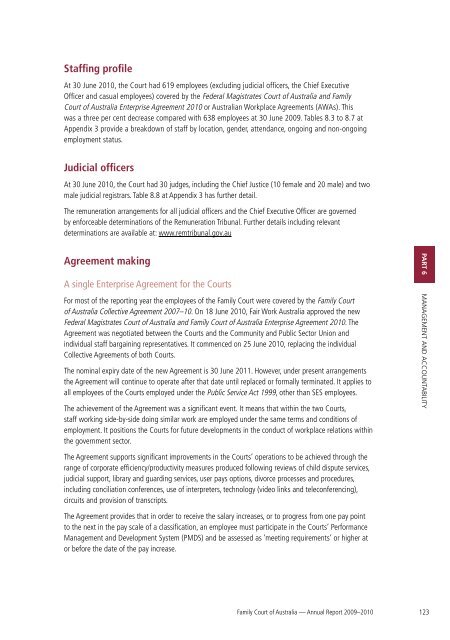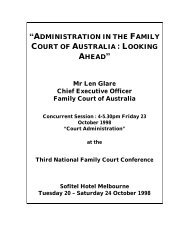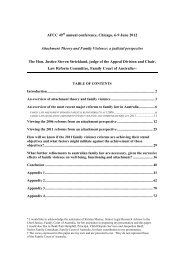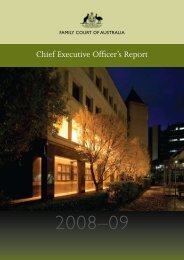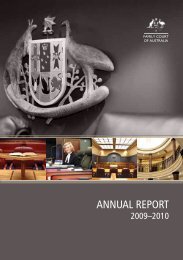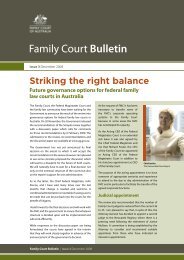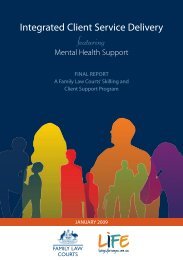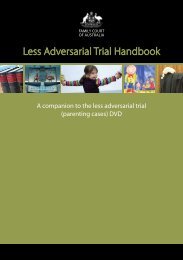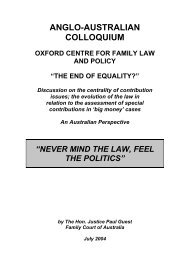pARt 6 MAnAGeMent AnD AccountABilitY - Family Court of Australia
pARt 6 MAnAGeMent AnD AccountABilitY - Family Court of Australia
pARt 6 MAnAGeMent AnD AccountABilitY - Family Court of Australia
- No tags were found...
You also want an ePaper? Increase the reach of your titles
YUMPU automatically turns print PDFs into web optimized ePapers that Google loves.
Staffing pr<strong>of</strong>ileAt 30 June 2010, the <strong>Court</strong> had 619 employees (excluding judicial <strong>of</strong>ficers, the Chief ExecutiveOfficer and casual employees) covered by the Federal Magistrates <strong>Court</strong> <strong>of</strong> <strong>Australia</strong> and <strong>Family</strong><strong>Court</strong> <strong>of</strong> <strong>Australia</strong> Enterprise Agreement 2010 or <strong>Australia</strong>n Workplace Agreements (AWAs). Thiswas a three per cent decrease compared with 638 employees at 30 June 2009. Tables 8.3 to 8.7 atAppendix 3 provide a breakdown <strong>of</strong> staff by location, gender, attendance, ongoing and non-ongoingemployment status.Judicial <strong>of</strong>ficersAt 30 June 2010, the <strong>Court</strong> had 30 judges, including the Chief Justice (10 female and 20 male) and twomale judicial registrars. Table 8.8 at Appendix 3 has further detail.The remuneration arrangements for all judicial <strong>of</strong>ficers and the Chief Executive Officer are governedby enforceable determinations <strong>of</strong> the Remuneration Tribunal. Further details including relevantdeterminations are available at: www.remtribunal.gov.auAgreement makingA single Enterprise Agreement for the <strong>Court</strong>sFor most <strong>of</strong> the reporting year the employees <strong>of</strong> the <strong>Family</strong> <strong>Court</strong> were covered by the <strong>Family</strong> <strong>Court</strong><strong>of</strong> <strong>Australia</strong> Collective Agreement 2007–10. On 18 June 2010, Fair Work <strong>Australia</strong> approved the newFederal Magistrates <strong>Court</strong> <strong>of</strong> <strong>Australia</strong> and <strong>Family</strong> <strong>Court</strong> <strong>of</strong> <strong>Australia</strong> Enterprise Agreement 2010. TheAgreement was negotiated between the <strong>Court</strong>s and the Community and Public Sector Union andindividual staff bargaining representatives. It commenced on 25 June 2010, replacing the individualCollective Agreements <strong>of</strong> both <strong>Court</strong>s.The nominal expiry date <strong>of</strong> the new Agreement is 30 June 2011. However, under present arrangementsthe Agreement will continue to operate after that date until replaced or formally terminated. It applies toall employees <strong>of</strong> the <strong>Court</strong>s employed under the Public Service Act 1999, other than SES employees.The achievement <strong>of</strong> the Agreement was a significant event. It means that within the two <strong>Court</strong>s,staff working side-by-side doing similar work are employed under the same terms and conditions <strong>of</strong>employment. It positions the <strong>Court</strong>s for future developments in the conduct <strong>of</strong> workplace relations withinthe government sector.PART 6 MANAGEMENT AND ACCOUNTABILITYThe Agreement supports significant improvements in the <strong>Court</strong>s’ operations to be achieved through therange <strong>of</strong> corporate efficiency/productivity measures produced following reviews <strong>of</strong> child dispute services,judicial support, library and guarding services, user pays options, divorce processes and procedures,including conciliation conferences, use <strong>of</strong> interpreters, technology (video links and teleconferencing),circuits and provision <strong>of</strong> transcripts.The Agreement provides that in order to receive the salary increases, or to progress from one pay pointto the next in the pay scale <strong>of</strong> a classification, an employee must participate in the <strong>Court</strong>s’ PerformanceManagement and Development System (PMDS) and be assessed as ‘meeting requirements’ or higher ator before the date <strong>of</strong> the pay increase.<strong>Family</strong> <strong>Court</strong> <strong>of</strong> <strong>Australia</strong> — Annual Report 2009–2010123


